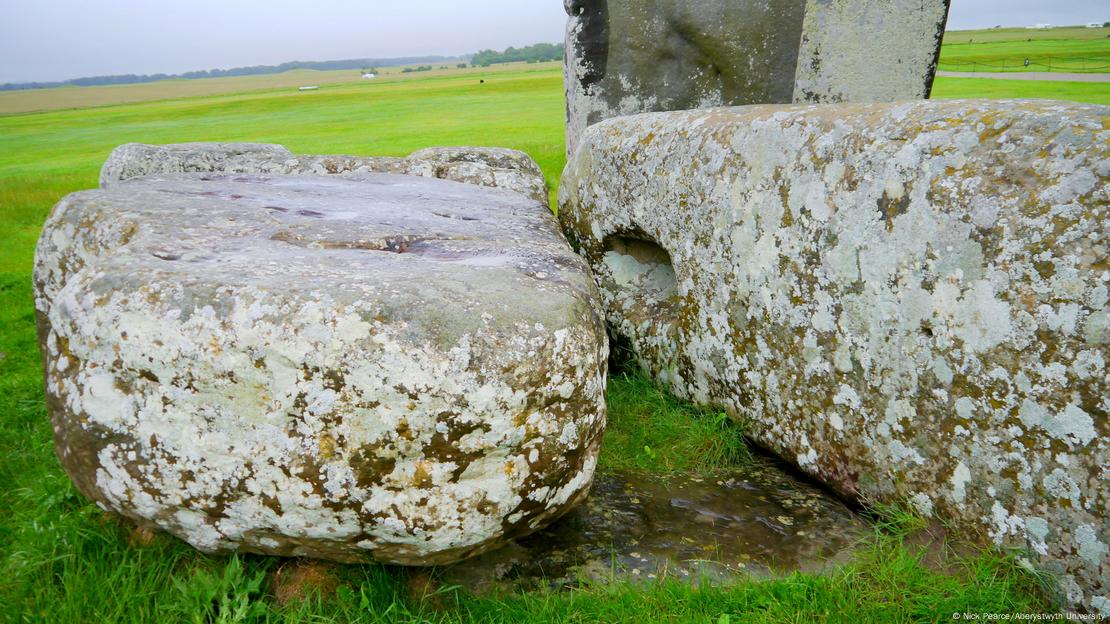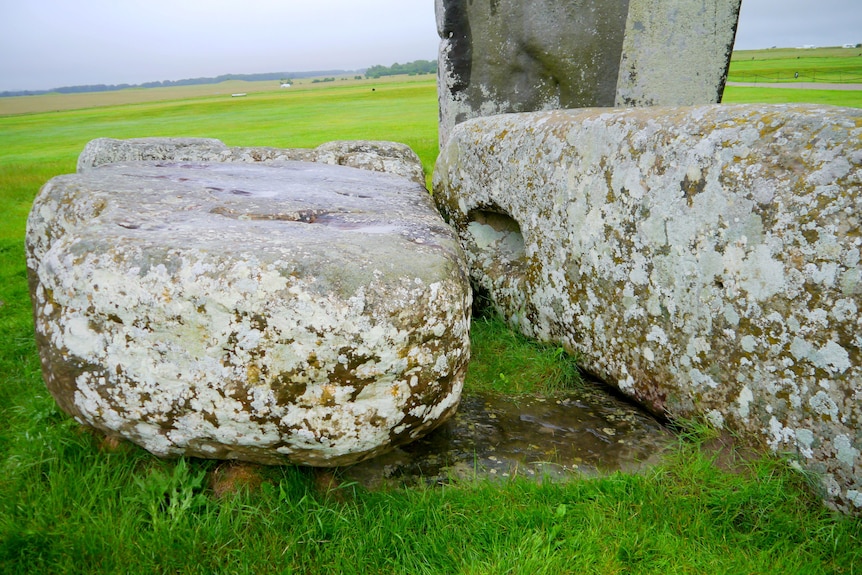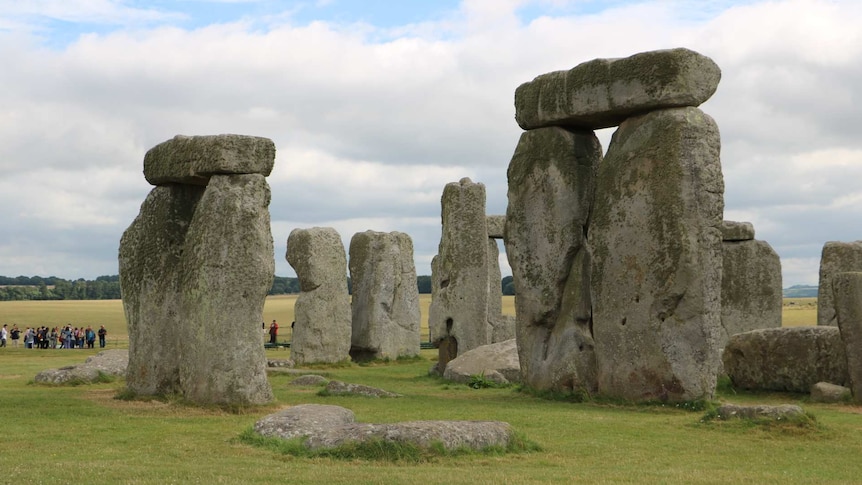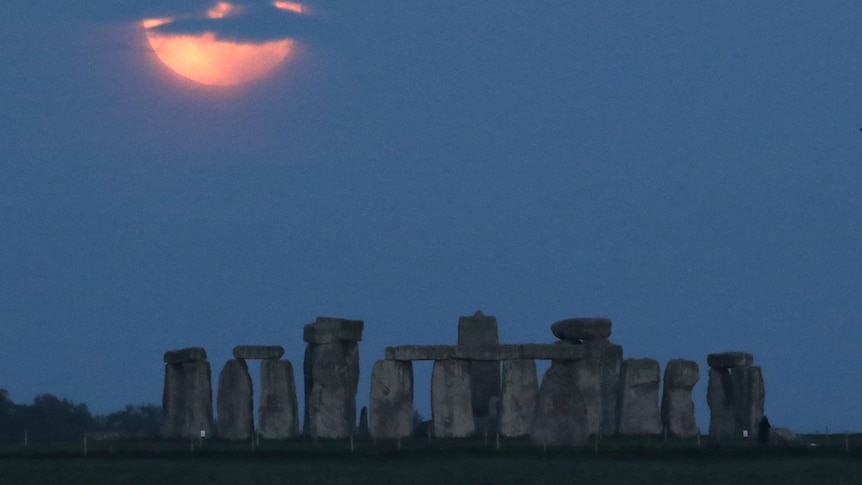Stonehenge monument altar stone came from Scotland via sea
DW
AUGUST 14,2024
"Completely unexpected" finding connects Stonehenge’s 6.6-ton Altar Stone to the northernmost parts of Great Britain and possible transport by ocean.
The origins of Stonehenge are slightly less mysterious now
Image: Toby Melville/REUTERS
A detailed chemical study of Stonehenge's central monolith has upended understanding of the British monument's mysterious origins, suggesting one of its central stones was transported from northern Scotland.
The findings more than triple the distance that the five-square-meter, six-ton sandstone slab might have traveled, compared to previous assumptions.
The 5,000-year-old neolithic stone circle is a treasured part of Britain's archeological heritage, visited by more than a million people each year. It's a site for annual solstice celebrations and most recently the subject of a controversial climate protest.
But how the structure was built remains uncertain.
Until last year, the Altar Stone was described as a 'bluestone' despite being found to be sedimentary sandstone, which was thought to have originated from a deposit near the Brecon Beacons in Wales.
Along with smaller dolerite and rhyolite bluestone boulders from the Mynydd Preseli deposits on the country’s west coast, it has long been thought that ancient Britons transported these rocks 225 kilmoters (140 miles) to construct Stonehenge. The site also features large slabs of locally-sourced sandstone.
But a report from the University of Aberystwyth last year found the Altar Stone's composition was fundamentally different from the sandstone of Wales, with its authors surmising an origin in northern Britain.
On a recommendation from the Aberystwyth team, tiny fragments of the Altar Stone were sent to the other side of the world – Western Australia – where a PhD student at Curtin University put them under the microscope.

The six-ton Altar Stone is submerged beneath these two sandstone slabs at Stonehenge.
Nick Pearce/Aberystwyth University
"Rock DNA" uncovers the origins of Stonehenge's Altar Stone
Stonehenge's large, central Altar Stone lies embedded in the earth beneath two larger sarsen sandstone blocks, which were sourced from the local Wiltshire region along with the other large upright stones that form the monument's outer circle.
But when the Aberystwyth researchers led by geologist Richard Bevins identified the possibility of a different origin for the Altar in 2023, it took a Welsh expat working on the other side of the world to fill in the gaps.
"I grew up kind of wandering those [Preseli] hills, much like, maybe, Neolithic Britons did thousands of years ago, and in some way that must have inspired me," said Anthony Clarke, a geologist originally from South Wales who currently works at Curtin University's Timescales of Mineral Systems group in Perth.

Anthony Clarke examines stone samples in his lab at Curtin University, Australia.
Image: Curtin University
Clarke and his colleagues performed an isotopic analysis of tiny decaying uranium fragments within the Altar Stone's crystals.
This process fires a laser into the rock slivers, measuring the ratio of uranium and lead released by the stone.
Using these measurements, Clarke and colleague Chris Kirkland – a Scotsman also working at Curtin – used an extensive geological database of the UK’s rock deposits to match the Altar Stone with the Orcadian Basin, about 850 kilometers north of Stonehenge.
"By measuring the isotopic ratios of uranium and lead within these little crystals, we have miniature 'clocks'," said Kirkland.
"These clocks are very handy because they tell us about the original age of the material that was eroded to produce our sandstone (...) we can look at lots of different crystals within the Altar Stone and build up an 'age fingerprint', much like DNA. It's like DNA for our rock."
Stonehenge: a story of seafaring trade?
Hauling a six-ton rock overland for more than 1,000 kilometers would have been a remarkable feat 6,000 years ago.
Instead, the researchers say the Altar Stone was probably transported over water.
"We initially thought it had to have been moved by ice – it's just such a long distance for humans to transport. But if we look at ice flow directions during previous ice ages in the UK, ice was actually moving even further away from southern Britain," Clarke said.
"If you look at overland transport of the Altar Stone, they would have to have passed some formidable barriers: rivers, the heavily forested nature of prehistoric Britain, the marshy boggy landscape and the mountains standing in the way, from northern Scotland (...) which then leaves us with a marine transport route."
Clarke points to evidence of sea-based trade, shipping and social connections throughout the British Isles at the time of Stonehenge's construction as supporting the ocean transport hypothesis.
It's similar to recent studies by archaeologists that uncovered the existence of an extinct branch of the Nile. Their analysis found the extinguished channel would have passed right by the site of many of the pyramids, indicating water transport was used by the Ancient Egyptians to transport the huge quantities of stone needed for their construction.
Clarke expects the water-transport hypothesis will draw a mix of responses from the archeological community but is confident this new Stonehenge study will help focus the search for the true source of the material used at the ancient site.
"I'm sure there's going to be a mixture of amazement and perhaps skepticism," Clark said.
"But this is something we welcome going forward, to really narrow down the source of the Altar Stone, perhaps to the individual outcrop or even quarry it might have been sourced from."
The new findings were published in the journal Nature.
Edited by: Derrick Williams
Primary source:
Clarke et al (2024). A Scottish provenance for the Altar Stone of Stonehenge. Nature. https://doi.org/10.1038/s41586-024-07652-1
Additional sources:
Bevins et al. (2023). The Stonehenge Altar Stone was probably not sourced from the Old Red Sandstone of the Anglo-Welsh Basin: Time to broaden our geographic and stratigraphic horizons? Published in Journal of Archaeological Science: Reports. https://doi.org/10.1016/j.jasrep.2023.104215
Bradley, Richard (2024). Beyond the bluestones: links between distant monuments in Late Neolithic Britain and Ireland. Antiquity. https://doi.org/10.15184/aqy.2024.3
Ghoneim et al (2024). The Egyptian pyramid chain was built along the now abandoned Ahramat Nile Branch. Communications Earth & Environment. https://doi.org/10.1038/s43247-024-01379-7
Clarke and his colleagues performed an isotopic analysis of tiny decaying uranium fragments within the Altar Stone's crystals.
This process fires a laser into the rock slivers, measuring the ratio of uranium and lead released by the stone.
Using these measurements, Clarke and colleague Chris Kirkland – a Scotsman also working at Curtin – used an extensive geological database of the UK’s rock deposits to match the Altar Stone with the Orcadian Basin, about 850 kilometers north of Stonehenge.
"By measuring the isotopic ratios of uranium and lead within these little crystals, we have miniature 'clocks'," said Kirkland.
"These clocks are very handy because they tell us about the original age of the material that was eroded to produce our sandstone (...) we can look at lots of different crystals within the Altar Stone and build up an 'age fingerprint', much like DNA. It's like DNA for our rock."
Stonehenge: a story of seafaring trade?
Hauling a six-ton rock overland for more than 1,000 kilometers would have been a remarkable feat 6,000 years ago.
Instead, the researchers say the Altar Stone was probably transported over water.
"We initially thought it had to have been moved by ice – it's just such a long distance for humans to transport. But if we look at ice flow directions during previous ice ages in the UK, ice was actually moving even further away from southern Britain," Clarke said.
"If you look at overland transport of the Altar Stone, they would have to have passed some formidable barriers: rivers, the heavily forested nature of prehistoric Britain, the marshy boggy landscape and the mountains standing in the way, from northern Scotland (...) which then leaves us with a marine transport route."
Clarke points to evidence of sea-based trade, shipping and social connections throughout the British Isles at the time of Stonehenge's construction as supporting the ocean transport hypothesis.
It's similar to recent studies by archaeologists that uncovered the existence of an extinct branch of the Nile. Their analysis found the extinguished channel would have passed right by the site of many of the pyramids, indicating water transport was used by the Ancient Egyptians to transport the huge quantities of stone needed for their construction.
Clarke expects the water-transport hypothesis will draw a mix of responses from the archeological community but is confident this new Stonehenge study will help focus the search for the true source of the material used at the ancient site.
"I'm sure there's going to be a mixture of amazement and perhaps skepticism," Clark said.
"But this is something we welcome going forward, to really narrow down the source of the Altar Stone, perhaps to the individual outcrop or even quarry it might have been sourced from."
The new findings were published in the journal Nature.
Edited by: Derrick Williams
Primary source:
Clarke et al (2024). A Scottish provenance for the Altar Stone of Stonehenge. Nature. https://doi.org/10.1038/s41586-024-07652-1
Additional sources:
Bevins et al. (2023). The Stonehenge Altar Stone was probably not sourced from the Old Red Sandstone of the Anglo-Welsh Basin: Time to broaden our geographic and stratigraphic horizons? Published in Journal of Archaeological Science: Reports. https://doi.org/10.1016/j.jasrep.2023.104215
Bradley, Richard (2024). Beyond the bluestones: links between distant monuments in Late Neolithic Britain and Ireland. Antiquity. https://doi.org/10.15184/aqy.2024.3
Ghoneim et al (2024). The Egyptian pyramid chain was built along the now abandoned Ahramat Nile Branch. Communications Earth & Environment. https://doi.org/10.1038/s43247-024-01379-7
The Altar Stone at the centre of Stonehenge may have come from more than 700km away in Scotland, Australian study suggests

The Altar Stone, seen here underneath two bigger sarsen stones.(Aberystwyth University: Nick Pearce)
Stonehenge, a UNESCO World Heritage Site, is located on the Salisbury Plain in Wiltshire, England, and is believed to have been constructed between 3100 BC and 1600 BC.
Previous research has identified two types of stone used to make its inner and outer rings.
WA-led research has unlocked secrets of Stonehenge
The outer ring is made up of standing sarsen stones originating from a location about 25km away, while the inner ring is made up of smaller "bluestones", of which the Altar Stone is the largest.
Lead researcher and Curtin University PhD candidate Anthony Clarke said their team had analysed two fragments of the stone.
"As of last year, the ultimate source of the Altar Stone was an open question," he said.
"We've had [work] ongoing on the Altar Stone … [and it] has a provenance all the way in the Orcadian Basin of north-east Scotland, some 700 to 800 kilometres away.
"This is a completely unexpected result, given that we thought it was going to originate in Wales."

Anthony Clarke said visiting the area as a child was part of what inspired him to research Stonehenge.(Supplied: Curtin University)
Professor Chris Kirkland of Curtin University's School of Earth and Planetary Sciences said they had examined the Altar Stone's "fingerprint" using the "little crystals" in the sandstone.
"What we can do is look at those little crystals … [they] contain small amounts of uranium, and we know the rate of change [from] uranium to lead," he said.
"By measuring the … uranium and lead within these little crystals, we have miniature clocks [that] tell us the original age of the material.
"We can [then] build up an age fingerprint, much like DNA for a rock. Then we can compare that to a large database of other rocks around the United Kingdom [and] compare the age."
The team also investigated several ways the stone could have moved or been transported such a long distance to its final location in the centre of the monument.
University of Adelaide associate professor Stijn Glorie, a co-supervisor of Mr Clarke's PhD studies, leads the Australian Research Council Project, which funded the research.
"We collected some data on minerals inside this [sample of the Altar Stone] to understand the fingerprints of the rocks and then link that with rocks in Britain," he said.
"What this study shows us is that there was a long, long transport mechanism involved for those people to bring the rocks from Scotland.
"We first looked at the possibility that these rocks were just supported by glaciers, and we could rule this out because of the flow directions of these glaciers at the time were the opposite direction.
"So it was kind of impossible. The other option would then be that these humans have transported it themselves.
"Over land that becomes tricky, because of huge obstacles along the way, so we quite quickly get to the conclusion that the only possible way really to bring that rock from Scotland to Stonehenge is over [the sea]."
Many questions surrounding Stonehenge, including its original purpose, remain unanswered.
"It's been something that's been, particularly in Britain's history, quite important," Dr Glorie said.
"So it's something that is in people's minds and understanding how it was built and how it was formed has clear importance for understanding history.
Scientists crack Stonehenge origin mystery
Geochemical testing indicates that 50 of Stonehenge's 52 pale-gray sandstone megaliths share a common origin about 25 kilometres away at a site called West Woods.

"One key question, and I don't think we can answer it at all, to be honest, is the why?
"Why would those people go all the way to Scotland to bring a rather unremarkable rock all the way to Stonehenge?
"Obviously there is no written record, so it's hard to work out why that would be so.
"We can only speculate on this, it's a very hard research question. Why would they have come all the way to Scotland [for] a rock that looks not much different to rocks that are locally sourced?
"Maybe it has some kind of spiritual meaning to them."
ABC NEWS AUSTRALIA

Stonehenge is a UNESCO World Heritage Site, but many things about it remain unknown.(Reuters: Peter Cziborra)
In short:
The 6-tonne Altar Stone inside Stonehenge may have come from a location in Scotland more than 700km away from its final placement, according to a new study.
"Fingerprinting" samples of the stone matched it to other samples in north-east Scotland, rather than Wales.
What's next?
Many questions, including how the stone may have been transported and what the original purpose of Stonehenge was, remain unanswered.
The 6-tonne stone at the centre of Stonehenge may have come from a location in Scotland more than 700km away from its final placement, new research has suggested.
The Altar Stone was long believed to have come from Wales, but may have been transported via sea, according to research led by Curtin University and published in science journal Nature.
The peer-reviewed study, funded by an Australian Research Council Discovery Project, was a collaboration between Curtin, the University of Adelaide, Aberystwyth University and University College London.
In short:
The 6-tonne Altar Stone inside Stonehenge may have come from a location in Scotland more than 700km away from its final placement, according to a new study.
"Fingerprinting" samples of the stone matched it to other samples in north-east Scotland, rather than Wales.
What's next?
Many questions, including how the stone may have been transported and what the original purpose of Stonehenge was, remain unanswered.
The 6-tonne stone at the centre of Stonehenge may have come from a location in Scotland more than 700km away from its final placement, new research has suggested.
The Altar Stone was long believed to have come from Wales, but may have been transported via sea, according to research led by Curtin University and published in science journal Nature.
The peer-reviewed study, funded by an Australian Research Council Discovery Project, was a collaboration between Curtin, the University of Adelaide, Aberystwyth University and University College London.
The Altar Stone, seen here underneath two bigger sarsen stones.(Aberystwyth University: Nick Pearce)
Stonehenge, a UNESCO World Heritage Site, is located on the Salisbury Plain in Wiltshire, England, and is believed to have been constructed between 3100 BC and 1600 BC.
Previous research has identified two types of stone used to make its inner and outer rings.
WA-led research has unlocked secrets of Stonehenge
The outer ring is made up of standing sarsen stones originating from a location about 25km away, while the inner ring is made up of smaller "bluestones", of which the Altar Stone is the largest.
Lead researcher and Curtin University PhD candidate Anthony Clarke said their team had analysed two fragments of the stone.
"As of last year, the ultimate source of the Altar Stone was an open question," he said.
"We've had [work] ongoing on the Altar Stone … [and it] has a provenance all the way in the Orcadian Basin of north-east Scotland, some 700 to 800 kilometres away.
"This is a completely unexpected result, given that we thought it was going to originate in Wales."
Anthony Clarke said visiting the area as a child was part of what inspired him to research Stonehenge.(Supplied: Curtin University)
Professor Chris Kirkland of Curtin University's School of Earth and Planetary Sciences said they had examined the Altar Stone's "fingerprint" using the "little crystals" in the sandstone.
"What we can do is look at those little crystals … [they] contain small amounts of uranium, and we know the rate of change [from] uranium to lead," he said.
"By measuring the … uranium and lead within these little crystals, we have miniature clocks [that] tell us the original age of the material.
"We can [then] build up an age fingerprint, much like DNA for a rock. Then we can compare that to a large database of other rocks around the United Kingdom [and] compare the age."
The team also investigated several ways the stone could have moved or been transported such a long distance to its final location in the centre of the monument.
University of Adelaide associate professor Stijn Glorie, a co-supervisor of Mr Clarke's PhD studies, leads the Australian Research Council Project, which funded the research.
"We collected some data on minerals inside this [sample of the Altar Stone] to understand the fingerprints of the rocks and then link that with rocks in Britain," he said.
"What this study shows us is that there was a long, long transport mechanism involved for those people to bring the rocks from Scotland.
"We first looked at the possibility that these rocks were just supported by glaciers, and we could rule this out because of the flow directions of these glaciers at the time were the opposite direction.
"So it was kind of impossible. The other option would then be that these humans have transported it themselves.
"Over land that becomes tricky, because of huge obstacles along the way, so we quite quickly get to the conclusion that the only possible way really to bring that rock from Scotland to Stonehenge is over [the sea]."
Many questions surrounding Stonehenge, including its original purpose, remain unanswered.
"It's been something that's been, particularly in Britain's history, quite important," Dr Glorie said.
"So it's something that is in people's minds and understanding how it was built and how it was formed has clear importance for understanding history.
Scientists crack Stonehenge origin mystery
Geochemical testing indicates that 50 of Stonehenge's 52 pale-gray sandstone megaliths share a common origin about 25 kilometres away at a site called West Woods.
"One key question, and I don't think we can answer it at all, to be honest, is the why?
"Why would those people go all the way to Scotland to bring a rather unremarkable rock all the way to Stonehenge?
"Obviously there is no written record, so it's hard to work out why that would be so.
"We can only speculate on this, it's a very hard research question. Why would they have come all the way to Scotland [for] a rock that looks not much different to rocks that are locally sourced?
"Maybe it has some kind of spiritual meaning to them."

No comments:
Post a Comment